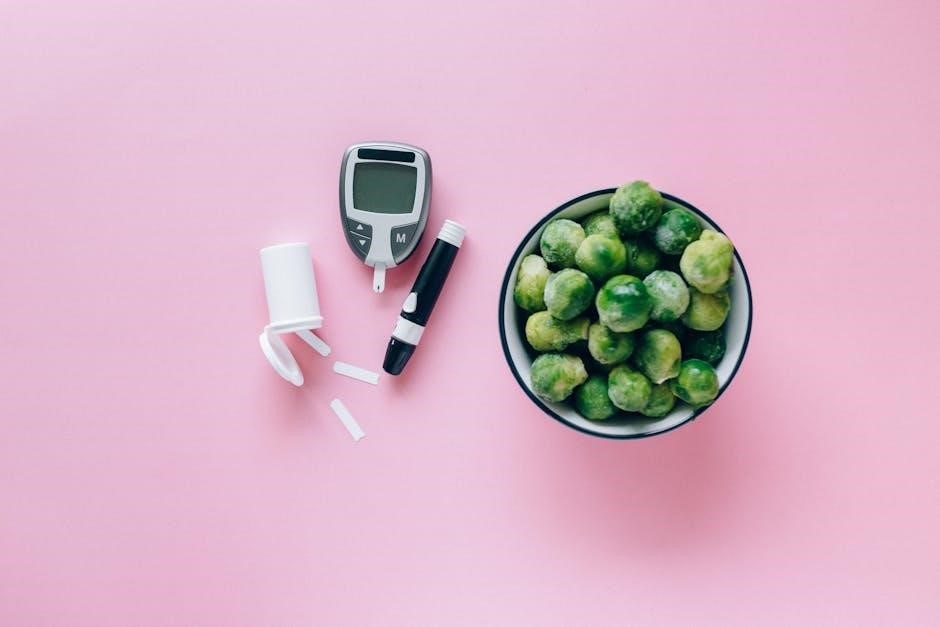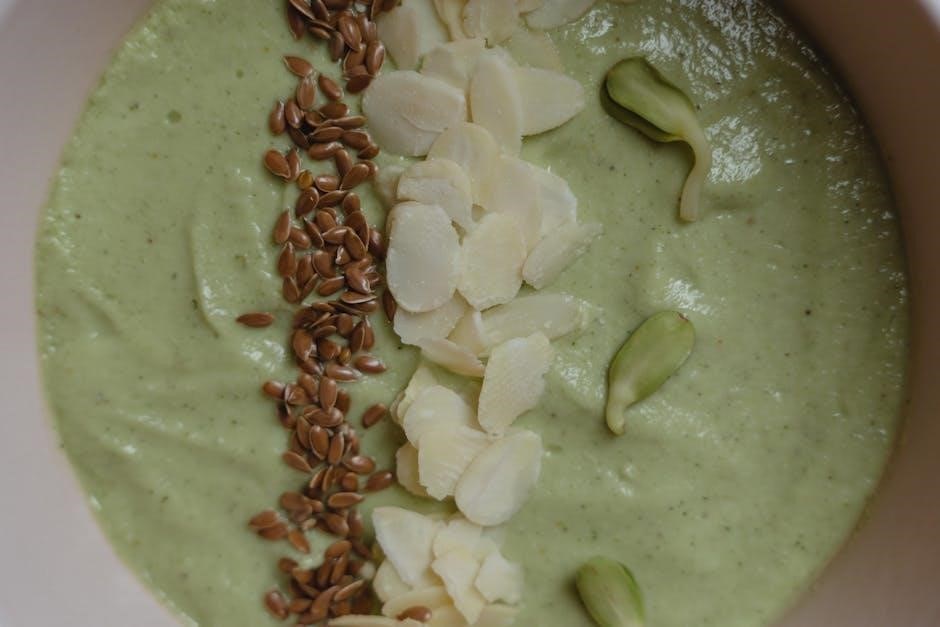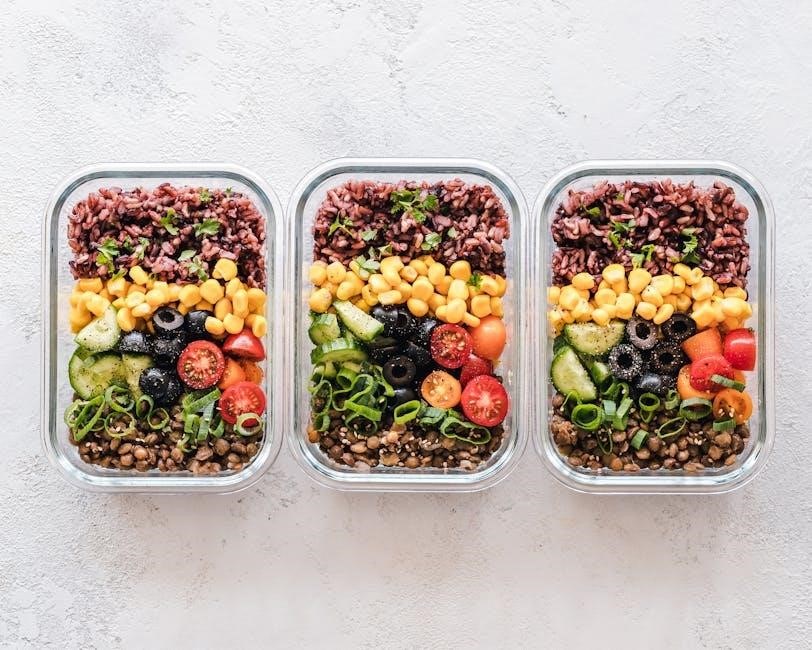
The low glycemic diet plan focuses on managing blood sugar levels by selecting foods with a low glycemic index, promoting sustainable weight loss and improving heart health naturally.
1.1 Understanding the Low Glycemic Diet
The low glycemic diet emphasizes foods with a low glycemic index (GI), which are digested slowly, preventing rapid blood sugar spikes. It focuses on whole, unprocessed foods like vegetables, lean proteins, and whole grains. By avoiding high-GI foods such as refined sugars and white bread, the diet helps stabilize blood sugar levels and promotes better energy balance. This approach is particularly beneficial for managing conditions like diabetes and supporting weight loss efforts. It encourages mindful eating and portion control for long-term health benefits.
1.2 Benefits of a Low Glycemic Diet
A low glycemic diet offers numerous benefits, including improved blood sugar control, enhanced weight management, and reduced risk of chronic diseases like heart disease and type 2 diabetes. By focusing on nutrient-dense foods, it supports sustained energy levels and can improve overall metabolic health. Additionally, it aids in lowering LDL cholesterol and triglycerides, promoting better cardiovascular well-being. This dietary approach is also associated with reduced inflammation, which can contribute to a lower risk of developing autoimmune conditions and other inflammatory disorders over time.

Key Components of a Low Glycemic Diet Plan
A low glycemic diet emphasizes whole, unprocessed foods, balanced macronutrients, and portion control to maintain stable blood sugar levels and support overall health effectively.
2.1 Foods to Include in a Low Glycemic Diet
A low glycemic diet focuses on whole, unprocessed foods to stabilize blood sugar levels. Include non-starchy vegetables like spinach, broccoli, and bell peppers, as well as lean proteins such as chicken, fish, and tofu. Whole grains like quinoa, brown rice, and oats are also recommended. Legumes, such as lentils, chickpeas, and kidney beans, are excellent choices due to their high fiber content. Healthy fats, including avocados, nuts, and olive oil, should also be incorporated. These foods help maintain steady energy levels and support overall health.
2.2 Foods to Avoid in a Low Glycemic Diet
A low glycemic diet requires avoiding foods that cause rapid blood sugar spikes. Limit or exclude refined carbohydrates, such as white bread, pasta, and rice, as well as sugary snacks like pastries and sodas. Processed foods with added sugars and unhealthy fats should also be avoided. These foods disrupt blood sugar balance and hinder weight management. Choosing whole, nutrient-dense foods supports stable energy and overall health.
2.3 The Role of Portion Control
Portion control is essential in a low glycemic diet to maintain balanced blood sugar levels. Even healthy foods, when overeaten, can spike glucose levels. Using smaller plates and measuring portions helps avoid overconsumption. Mindful eating practices ensure that meals are satisfying without excess. Controlling portion sizes supports weight management and prevents insulin resistance, making it a cornerstone of long-term success on the low glycemic plan.
2.4 Understanding the Glycemic Index (GI)

The Glycemic Index (GI) ranks foods based on how quickly they raise blood sugar levels. Low GI foods (0-55) digest slowly, preventing sharp spikes, while high GI foods (70+) cause rapid increases. Understanding GI helps in selecting foods that stabilize blood sugar, promoting better energy levels and weight management. Incorporating low GI options like whole grains, non-starchy vegetables, and legumes supports heart health and reduces diabetes risks, making it a key component of the low glycemic diet plan.

Health Benefits of a Low Glycemic Diet
The low glycemic diet offers health benefits like reduced chronic disease risk, improved energy, better digestion, and well-being by stabilizing blood sugar and promoting nutrition.
3.1 Managing Blood Sugar Levels
Managing blood sugar levels is a cornerstone of the low glycemic diet. By focusing on low GI foods, it prevents sharp spikes in glucose, aiding insulin function. This approach helps maintain stable blood sugar levels, reducing the risk of complications. Incorporating protein, fiber, and healthy fats slows digestion, enhancing glucose control. Regular monitoring and balanced meals are key to effective blood sugar management, promoting overall metabolic health and energy stability throughout the day. This method is particularly beneficial for those with diabetes or prediabetes.
3.2 Promoting Weight Loss
The low glycemic diet plan is effective for weight loss as it stabilizes blood sugar, reducing hunger and cravings. Low GI foods prevent rapid spikes in insulin, promoting fat burning and metabolism. By focusing on nutrient-dense foods like vegetables, lean proteins, and whole grains, the diet helps maintain satiety, leading to natural calorie reduction. portion control and balanced meals further support weight management, making it easier to achieve and maintain a healthy weight without extreme restrictions or deprivation.
3.3 Improving Heart Health

A low glycemic diet plan supports heart health by reducing inflammation and blood sugar spikes, which can damage blood vessels. It lowers cholesterol levels by limiting saturated and trans fats, improving blood lipid profiles. The diet emphasizes whole, nutrient-rich foods like vegetables, lean proteins, and whole grains, which help regulate blood pressure and reduce cardiovascular risk factors. By stabilizing blood sugar and improving insulin sensitivity, the diet contributes to a healthier cardiovascular system, lowering the risk of heart disease and stroke;

Sample Low Glycemic Diet Meal Plan
A well-structured meal plan featuring low glycemic foods ensures balanced nutrition, stabilizes blood sugar, and supports weight management through healthy, sustainable eating habits.
4.1 Breakfast Ideas

Start your day with a nutrient-rich breakfast that balances low glycemic foods. Options include scrambled eggs with spinach, avocado toast on whole-grain bread, or a Greek yogurt parfait with berries and chia seeds. Oatmeal topped with nuts and a drizzle of honey is another excellent choice. Smoothies made with leafy greens, citrus fruits, and almond milk are refreshing and packed with nutrients. Incorporate protein sources like tofu or quinoa for sustained energy, ensuring your meal keeps blood sugar levels stable and energizes you for the morning ahead.
4.2 Lunch and Dinner Options
For lunch and dinner, focus on balanced meals with lean proteins, non-starchy vegetables, and whole grains. Grilled chicken or fish paired with roasted broccoli, Brussels sprouts, or asparagus makes a satisfying option. Include a side of quinoa, brown rice, or lentils for fiber. Stir-fries with tofu, mixed vegetables, and herbs like garlic and ginger are flavorful and nutritious. Salads with chickpeas, avocado, and a light vinaigrette are also ideal. Ensure meals are seasoned with spices to enhance flavor without added sugars or unhealthy fats.
4.3 Healthy Snacks
Healthy snacks on a low glycemic diet include raw vegetables like carrots, celery, and cucumbers, paired with hummus or guacamole. Nuts and seeds, such as almonds, walnuts, chia seeds, and flaxseeds, are excellent choices due to their low glycemic index. Fresh berries, citrus fruits, or apples with a handful of nuts provide natural sweetness and fiber. Hard-boiled eggs, cottage cheese, or a small serving of Greek yogurt are protein-rich options that keep blood sugar stable. Portion control is key to maintaining metabolic balance and preventing overeating.

Lifestyle Tips for Succeeding on a Low Glycemic Diet
Staying hydrated, incorporating physical activity, and monitoring progress are essential for long-term success on a low glycemic diet, ensuring sustained health benefits and metabolic balance.
5.1 Staying Hydrated
Drinking plenty of water is crucial for overall health and digestion. Hydration aids in maintaining stable blood sugar levels and supports metabolism. Incorporate water-rich foods like cucumbers and melons to enhance hydration naturally. Herbal teas and clear soups can also contribute to daily fluid intake without spiking blood glucose. Avoid sugary drinks and opt for water or unsweetened beverages to stay hydrated and support your low glycemic diet goals effectively.

5.2 Incorporating Physical Activity
Regular physical activity complements a low glycemic diet by improving insulin sensitivity and promoting weight management. Aim for at least 150 minutes of moderate-intensity exercise, such as brisk walking, cycling, or swimming, weekly. Strength training and high-intensity interval training can also enhance metabolic health. Even light activities like yoga or gardening contribute to overall well-being. Consistency is key to maintaining energy levels and supporting long-term health goals while adhering to your low glycemic diet plan.
5.4 Monitoring Progress
Tracking your progress is essential to staying motivated and ensuring the diet’s effectiveness. Regularly monitor weight, blood sugar levels, and measurements. Adjust your food choices and portion sizes as needed to maintain steady improvement. Keep a food diary to record meals and physical activity, helping identify patterns and areas for improvement. Schedule periodic check-ups with a healthcare provider to assess overall health and make necessary adjustments to your low glycemic diet plan for optimal results.